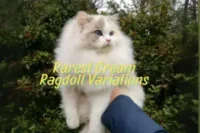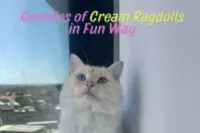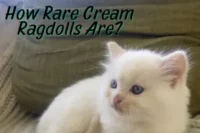Cream Tortie Ragdoll: A Creamy Patchwork Beauty
Published: 18 Sep 2025
Today we are going to introduce a Cream Ragdoll cat with the softest mix of cream, peach and apricot patches? Yes, I am talking about Cream Tortie Ragdoll, one of the most enchanting and rare coat patterns in this breed. We absolutely adore these pastel-colored fluffballs and every time we meet one, it feels like spotting a little piece of living artwork.
In this guide, we will share everything we have learned about Cream Tortie Ragdolls from how their appearance changes as they grow, to which parents can pass down this coat pattern, to just how rare these kitties truly are. We will even sprinkle in some fun facts and clear up a few myths that tend to swirl around tortie cats.
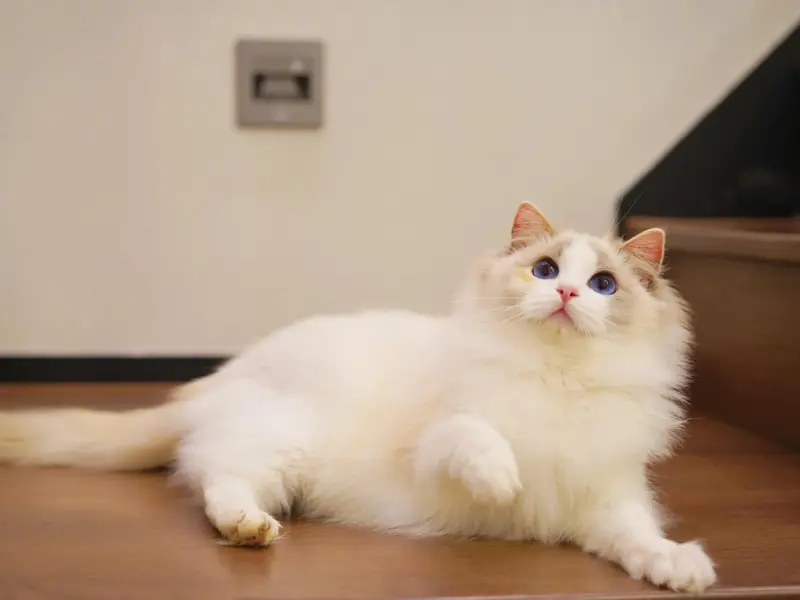
Our goal is to help fellow Ragdoll parents and cat lovers understand and appreciate this gorgeous variation. After all, knowing what makes these cats special can make the bond we share with them even deeper.
So, are you ready to curl up with us and explore the world of Cream Tortie Ragdolls? 🐾 Let’s dive right in!
What is a Cream Tortie Ragdoll?
A Cream Tortie Ragdoll is a Ragdoll cat with a very special coat pattern called “tortie,” short for tortoiseshell. Tortie simply means the fur shows a pretty mix of two colors and in this case, there are two creamy white and soft peachy-apricot patches. On a Cream Tortie Ragdoll, these colors blend together in a dreamy way that makes them look like little marshmallow clouds with splashes of sunlight.
Like all Ragdolls, they still have those signature deep blue eyes, silky fur and sweet personalities. The only difference is their “outfit” which is a unique, patchwork coat that no two cats ever share exactly the same way. Each Cream Tortie Ragdoll wears her colors like a one-of-a-kind painting.
One thing that makes this variation even more fascinating is that almost all tortie cats are female. That’s because of how their color genes work (don’t worry, we will explain this in simple terms later on). So when we see a Cream Tortie Ragdoll, we already know she’s a very special lady.
These cats are rare, eye-catching and absolutely full of charm. But beyond their pastel beauty, they are still the same gentle cuddle buddies that make Ragdolls such a beloved breed. Isn’t it amazing how much variety nature paints into our fluffy companions?
Appearance of a Cream Tortie Ragdoll
The first thing anyone notices about a Cream Tortie Ragdoll is her dreamy coat. The fur looks soft and pastel like someone brushed light cream and peachy-apricot colors across a fluffy white canvas. Instead of one solid shade, you will see gentle patches and swirls that make every Cream Tortie completely unique. No two are ever marked the same which is part of their magic.
Coat Colors and Patterns
- Base color: a soft creamy white.
- Patches: peach, apricot or light orange shades that appear mainly on the ears, face mask and tail.
- Paws and legs: may show little mottled patches of color or stay lighter.
- Body: often stays paler, giving a soft contrast to the points.
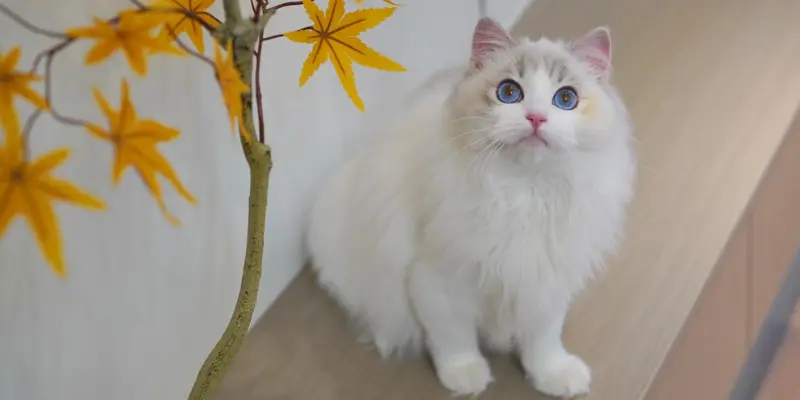
Eyes and Fur
- Their eyes are always striking and deep blue, one of the most loved features of Ragdolls.
- The fur itself is medium to long, silky, and plush which makes the pastel colors look even softer.
Overall Look
When you see a Cream Tortie Ragdoll, the word “gentle” comes to mind. Their colors don’t scream bold or dramatic. Instead, they look like delicate watercolor paintings. Many people say these cats resemble little “cotton candy clouds” which are fluffy, light and impossible not to admire.
It’s this combination of gentle colors, silky coat and those unforgettable blue eyes that makes Cream Tortie Ragdolls feel like walking pieces of art. Don’t you agree they look like cuddly masterpieces?
Who’s Behind the Fluff? Which Parents Can Create a Cream Tortie Ragdoll?
One of the most fascinating things about Cream Tortie Ragdolls is how their colors come to life through genetics. Don’t worry, we will keep it simple and easy to follow.
The Role of Genetics
Tortie (tortoiseshell) patterns happen because of special color genes that are carried on the X chromosome. Since female cats have two X chromosomes, they can show two different colors on their coat at the same time. In this case, cream and apricot cross each other. Male cats with only one X chromosome, almost never end up with tortie coats. That’s why Cream Tortie Ragdolls are nearly always female.
Parent Combinations
To welcome a Cream Tortie Ragdoll kitten, the parents need to pass down just the right genes:
- A mother who carries cream or tortie coloring.
- A father who carries the colorpoint pattern (the classic Ragdoll look with darker ears, tail and mask).
When these genes mix, magic happens and a Cream Tortie kitten can appear in the litter.
A Fun Twist
Even when two Ragdoll parents have the right colors, not every kitten will be a Cream Tortie. That’s what makes these cats feel extra special, it’s like winning the genetic lottery of fluff!
From Kitten to Queen: How a Cream Tortie Ragdoll’s Colors Change Over Time
One of the most magical parts of raising a Cream Tortie Ragdoll is watching her colors slowly appear and blossom. Unlike some other pets, Ragdolls don’t show their full beauty at birth. It’s a journey of gentle surprises.
Day 1– A Snowy Start
When Cream Tortie kittens are born, they look almost pure white. Their silky fur is like fresh snow and it can be hard to imagine the pastel magic hiding underneath.
Weeks 2 to 6– The First Hints
As the days pass, faint cream and peach patches start to peek through, usually on the ears, nose and tail. At this stage, the markings are soft and blurry like little whispers of color.
3 to 6 Months– Pastels in Bloom
By the time they are a few months old, Cream Tortie Ragdolls begin to show their true personalities in their coats. The apricot and cream shades grow richer and you will notice more mottled patterns on the mask, ears and tail.
Adulthood– A Painted Masterpiece
As adults, their pastel shades settle into a beautiful blend of cream and peachy tones. Some girls develop stronger patches while others keep a more delicate watercolor look. Either way, no two Cream Tortie Ragdolls ever look the same with each one wearing a one-of-a-kind coat.
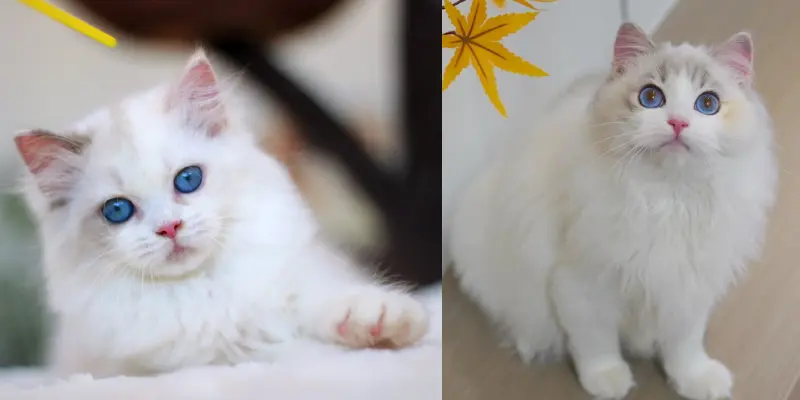
Watching these changes feels like unwrapping a gift over time. Every month brings new colors and patterns, making us fall in love with them all over again. Isn’t it amazing how our fluffy companions transform right before our eyes?
How Rare Are Cream Tortie Ragdolls?
If you have ever met a Cream Tortie Ragdoll in person, consider yourself lucky! These pastel beauties are quite rare compared to other Ragdoll colors.
Why They’re Rare
- Genetics: Since the tortie pattern is linked to the X chromosome, almost all Cream Tortie Ragdolls are female. That already cuts the numbers down.
- Color mix: The cream and peach blend is not as common as darker variations like seal ragdolls or blue. It takes just the right pairing of parents to create this look.
- Small chance in litters: Even when the right genes are there, not every kitten will turn out Cream Tortie.
Comparing Rarity
- Common colors: Seal and blue Ragdolls are the most widely seen.
- Less common: Lilac, chocolate and flame (red).
- Rare gems: Cream Tortie Ragdolls, along with other tortie variations, sit high on the rarity list.
The Special Factor
Owning a Cream Tortie Ragdoll often feels like having a little treasure in your home. They are not just rare in looks but also in the joy of watching such a delicate and unusual coat develop.
Cream Tortie Ragdolls vs. Other Colors: Spotting the Differences
One of the most fun parts of being a Ragdoll parent is learning to tell the coat variations apart. Cream Tortie Ragdolls often stand out for their soft and pastel look but how do they compare to other Ragdoll colors? Let’s take a closer peek. 🐾
Cream Tortie vs. Cream Point
- Cream Point: Shows one solid creamy-apricot shade on the ears, face and tail.
- Cream Tortie: Has a patchwork blend of cream and peachy-apricot, giving a more mottled and watercolor effect.
Cream Tortie vs. Blue Tortie
- Blue Tortie: Mixes gray-blue with cream, creating a cooler and sometimes darker appearance.
- Cream Tortie: Looks much lighter and warmer with peachy hints instead of gray.
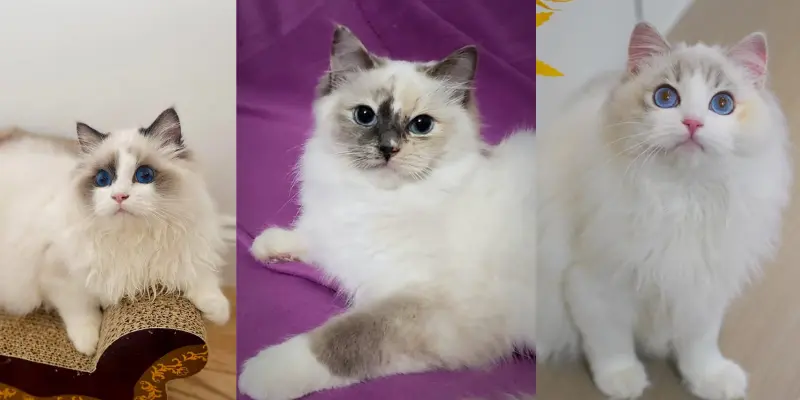
Cream Tortie vs. Seal Tortie
- Seal Tortie: Deep chocolate brown mixed with cream, having bold and striking.
- Cream Tortie: Soft and pastel, almost like cotton candy compared to the richness of the seal colour.
The Pastel Advantage
Cream Tortie Ragdolls are the “softest” looking of all the tortie variations. Their coats have that dreamy, cloud-like effect that makes them extra enchanting.
Each Ragdoll color has its charm but Cream Torties hold a special spot for those of us who love light and airy tones. Don’t they look like they’ve been brushed with sunshine?
Fun Facts & Myths About Cream Tortie Ragdolls
Every Cream Tortie Ragdoll has a story written right on her coat and along with that, plenty of fun little facts and myths surround these pastel queens. Let’s clear up a few and share some lighthearted truths.
Fun Facts
- One-of-a-kind coats: No two Cream Tortie Ragdolls ever look the same. Each kitty wears her own patchwork design like a tiny piece of living art.
- The “diva” reputation: Tortie cats in general are sometimes nicknamed “divas” because of their bold markings. But our Ragdolls? They keep their gentle, floppy, cuddle-bug nature.
- A pastel rarity: Among all tortie patterns, the Cream Tortie is one of the lightest and softest-looking. Many people describe them as “cotton candy clouds” or “sunrise cats.”
- Nature’s surprise: Even experienced breeders can not always predict if a litter will produce a Cream Tortie. It’s always a joyful surprise.
Myths
- Myth: Torties bring bad luck.
Some old tales say tortie cats carry misfortune but in many cultures, they are actually considered good luck! And in our homes, they bring nothing but purrs and happiness. - Myth: Tortie cats have fiery tempers.
While some torties may be more spirited, Ragdoll personalities stay calm, sweet and loving, no matter their coat.
We like to think Cream Tortie Ragdolls carry a little extra sparkle thanks to their pastel patches but underneath, they are the same affectionate and gentle cuddle buddies Ragdolls are famous for. Isn’t it wonderful when beauty and sweetness come together in one fluffy package?
Should You Adopt a Cream Tortie Ragdoll?
If you are dreaming about bringing a Cream Tortie Ragdoll into your home, we can tell you that they’re just as sweet as they are beautiful. Like all Ragdolls, these pastel queens are gentle, affectionate and love to follow us from room to room like fluffy shadows.
Why You’ll Love Them
- Unique beauty: Every Cream Tortie has her own one-of-a-kind coat. No two look alike.
- Calm nature: Despite the “tortie diva” reputation in other breeds, Ragdolls stay true to their soft and floppy personalities.
- Family-friendly: They get along well with children, other pets and anyone who enjoys cuddle time.
- Rare treasure: Owning one feels extra special because they are not easy to find.
Things to Keep in Mind
- They are rare, so you may need patience if you are looking for one from a breeder.
- Focus on health and personality first. Coat color is the icing on the cake but a happy and healthy kitty is what truly matters.
- Like all Ragdolls, they thrive on love, attention and being part of the family.
If you are lucky enough to welcome a Cream Tortie Ragdoll then you will not only enjoy her pastel beauty but also her warm and loyal companionship. After all, what could be better than a rare fluffball who doubles as your best cuddle buddy?
Conclusion
Cream Tortie Ragdolls are truly one-of-a-kind treasures. With their soft cream and peachy-apricot coats, striking blue eyes and gentle nature, they are like pastel masterpieces that purr. From the snowy-white kitten days to their full-grown patchwork beauty, watching their colors bloom is a magical journey every Ragdoll parent cherishes.
They may be rare but that only adds to their charm. Whether you are already lucky enough to share your home with a Cream Tortie or you are simply dreaming of one, these cats remind us just how unique and wonderful our fluffy companions can be.
At the end of the day, it’s not just about their rare coloring but it’s about the love, loyalty and cuddles they bring into our lives. And in that sense, every Ragdoll is a true work of heart with no matter of their color
Purr-some Questions: FAQs About Cream Tortie Ragdolls
We have gathered some of the most common questions cat lovers ask about Cream Tortie Ragdolls. If you are curious then you’re not alone, these pastel beauties always spark a lot of interest! 🐾
Almost never. Since tortie coloring comes from the X chromosome and males only have one, it’s extremely rare for them to be torties. The rare exceptions are usually due to genetic quirks and are very uncommon.
They are quite rare! Seal and blue Ragdolls are the most common. Cream Torties with their soft pastel coats are much harder to find.
Yes. They are born almost white and their cream and peach patches appear gradually. By adulthood, their coats become more distinct, though still soft and dreamy in appearance.
Sometimes, yes. Because of their rarity, breeders may price them a little higher than common colors. But prices also depend on health, pedigree and breeder reputation.
No, their personality is the same sweet, floppy affectionate one we love in all Ragdolls. Myths about torties being feisty don’t apply here, these cats are just as cuddly as any other Ragdoll.
Absolutely! They adore being part of the family, love children and often get along with other pets. They thrive on attention and companionship.
Have a question we did not answer? We’d love to hear from you. After all, sharing stories and tips about our Ragdolls is one of our favorite things!

- Be Respectful
- Stay Relevant
- Stay Positive
- True Feedback
- Encourage Discussion
- Avoid Spamming
- No Fake News
- Don't Copy-Paste
- No Personal Attacks



- Be Respectful
- Stay Relevant
- Stay Positive
- True Feedback
- Encourage Discussion
- Avoid Spamming
- No Fake News
- Don't Copy-Paste
- No Personal Attacks


